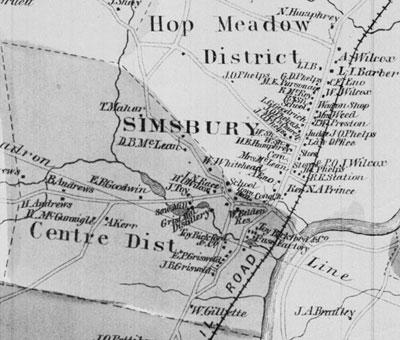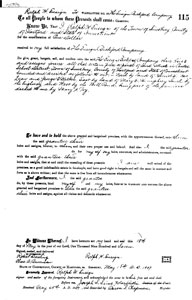

 During
the 1850's and 1860's,
Simsbury consisted of some thirteen school districts and the area which became
West Street and Maple Court as well as the area around the Toy, Bickford, and
Company fuse factory were part of the Centre District. This area was the geographical
center of town, yet despite its central location, the Centre District remained
one of the town's least developed areas in 1860.
During
the 1850's and 1860's,
Simsbury consisted of some thirteen school districts and the area which became
West Street and Maple Court as well as the area around the Toy, Bickford, and
Company fuse factory were part of the Centre District. This area was the geographical
center of town, yet despite its central location, the Centre District remained
one of the town's least developed areas in 1860.
A 1869 Baker and Tilden map of the Simsbury Centre District (at left) reveals some of the land and homeowners in the area at the time. These include the Belden family (house demolished, formerly in the area of One West Street condominum complex), James N. Race (46 West St), Henry O. Wilcox (52 West St), Joseph Toy (70 West St), and Edward B. Goodwin (122 West St). Also in the area was town hall (now a Boy Scout Hall, which was later moved to its current location to the north of the Congregational Church), a small school house off Firetown Road, and Tuller's saw and gristmill (73/77 West St, c.1800), and a distillery along Hop Brook. The gristmill is on the site of Simsbury's oldest saw and gristmill c. 1680.
In 1864, Joseph Toy, principal partner and executive of the Toy, Bickford, & Company Fuse Factory, purchased approximately 6 acres of land, a house, and barn from Edward B. Goodwin (122 West St) along what is now West Street for $700 (Simsbury Land Records 46: 167). The land included the northly section of West Street from Bushy Hill Road to approximately what is now 52 West Street, then owned by Henry O. Wilcox). This added to Toy's property in the area which also included a grist and hemp mill on property on the south side of West Street. Upon Joseph Toy's death in 1887 and having outlived two male heirs, Joseph Toy's shares in Toy, Bickford, and Company and expanse of property in town passed to his five daughters. The land that eventually became Maple Court passed temporarily to Mary A. Toy, one of Toy's daughters.
One of Toy's sons-in-law, Ralph Hart Ensign (1834-1917), immediately identified the potential for instability in the company if a clear administrative system was not put in place after Toy's death. He arranged with Charles Edson Curtiss and Lemuel S. Ellsworth, also Toy's sons-in-law, to buy out the remaining sisters who husbands were clergymen. Ensign, Curtiss and Ellsworth then created a new partnership, known as Ensign, Bickford and Company. Several years after the partnership was formed, Ralph Hart Ensign purchased the original six acre tract of land that his father-in-law Joseph Toy bought from Edward B. Goodwin for $1600 on September 16, 1900 from his sister-in-law Mary A. Toy (Simsbury Land Records 54: 437).

The warrantee deed from Mr. Ralph Hart Ensign to Ensign-Bickford Company dated 20 May 1907 which gave the land to the company. The land later formed what is now the Maple Court subdivision. Source: Simsbury Land Records volume 57, page 115. [Click for PDF of the deed]
Shortly after Mr. Ensign purchased the property in 1900 from his sister-in-law Mary Toy, he sold a portion of the land to Mary E. Humphrey for $250 on March 20, 1902 (Simsbury Land Records 54: 500). Miss Humphrey allowed her friends, Mr. and Mrs. Matthew E. McDonald, to build an impressive queen anne style home on the property (1 Old Mill Lane, Simsbury) and she lived with them according to the US Federal Census listings in 1880, 1900 and 1910. In 1909, Miss Humphrey gave the property to the McDonalds for one dollar with the provision that she would be allowed the undivided use of the premises and all improvements thereon for her life (Simsbury Land Records 57: 173). Ms. Humphrey died 10 years later on 2 Dec 1919. Matthew E. McDonald became the 19th postmaster for the Town of Simsbury and served from February 13, 1913 until his death in 1928. Upon his death, through a series of land transactions, the property eventually became owned by Ralph Ensign’s son, Joseph R. Ensign, who was then the president of EB Co, who apparently gave it for an undisclosed amount (most likely one dollar) to Ensign-Bickford Company in November, 1928 (Simsbury Land Records 65: 171). A company inventory showing its tenement properties reveals that the McDonald house cost $14,300.00. EB Co used the One Old Mill property to house a company executive, Mr. J. Frank Bryne, who lived in the home until his death in 1970. The company converted it to commercial use and retained it well into the 1990's. It is now the corporate offices of Coburn *& Meredith, Inc.
Seven years after Ralph H. Ensign purchased the land from his sister-in-law, he sold a certain parcel of land which later became Maple Court for one dollar to the newly incorporated Ensign-Bickford Company which he headed on May 18, 1907 (Simsbury Land Records 57: 115) . On the warrantee deed the land was described as follows:
"A certain piece or parcel of land situate[d] in Center School District, Town of Simsbury, County of Hartford and State of Connecticut bounded and described as follows to writ: -- North by land of Harriet McLean and George E. Walker, East by land of Mary E. Humphrey, South by the highway and West by the Mill Pond being part of the premises deeded to me by Mary A. Toy."
Shortly thereafter in the same year, Ensign-Bickford Company built its first two employee tenement houses on West Street (82 and 86 West Street) and began a subdivision and development which later in the early 1930's became known as Maple Court. The houses on West Street became the third area in town, following Hopmeadow/Woodland Street and Pine Hill, in which the Ensign-Bickford Company began to develop housing for its employees in close proximity to its fuse factory plant. The ten houses of Maple Court were built over a 25 year period and the company also came to build and own many other properties in the surrounding area along West Street and Old Mill Lane over the next thirty years. The land donated to Ensign-Bickford Company was a small portion of a six acre piece of land that Mr. Ensign had purchased from his sister-in-law, Mary Toy, in 1900 and was directly across the street from the gristmill that Mr. Ensign also owned at the time.
« Overview | » Street and Neighborhood
Home | History | Association | News | Directions | Resources | Contact
Maintained by the Maple Court Home Owners' Association, Inc. Copyright © 2008-11, MCHOA Inc. All Rights Reserved.